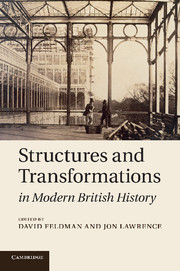Book contents
- Frontmatter
- Contents
- List of figures
- Notes on contributors
- Introduction: structures and transformations in British historiography
- 1 Coping with rapid population growth: how England fared in the century preceding the Great Exhibition of 1851
- 2 The ‘urban renaissance’ and the mob: rethinking civic improvement over the long eighteenth century
- 3 Forms of ‘government growth’, 1780–1830
- 4 Family formations: Anglo India and the familial proto-state
- 5 The commons, enclosure and radical histories
- 6 Engels and the city: the philosophy and practice of urban hypocrisy
- 7 The decline of institutional reform in nineteenth-century Britain
- 8 British women and cultures of internationalism, c.1815–1914
- 9 Psychoanalysis, history and national culture
- 10 Labour and the politics of class, 1900–1940
- 11 The dialectics of liberation: the old left, the new left and the counter-culture
- 12 Why the English like turbans: multicultural politics in British history
- Index
1 - Coping with rapid population growth: how England fared in the century preceding the Great Exhibition of 1851
Published online by Cambridge University Press: 04 February 2011
- Frontmatter
- Contents
- List of figures
- Notes on contributors
- Introduction: structures and transformations in British historiography
- 1 Coping with rapid population growth: how England fared in the century preceding the Great Exhibition of 1851
- 2 The ‘urban renaissance’ and the mob: rethinking civic improvement over the long eighteenth century
- 3 Forms of ‘government growth’, 1780–1830
- 4 Family formations: Anglo India and the familial proto-state
- 5 The commons, enclosure and radical histories
- 6 Engels and the city: the philosophy and practice of urban hypocrisy
- 7 The decline of institutional reform in nineteenth-century Britain
- 8 British women and cultures of internationalism, c.1815–1914
- 9 Psychoanalysis, history and national culture
- 10 Labour and the politics of class, 1900–1940
- 11 The dialectics of liberation: the old left, the new left and the counter-culture
- 12 Why the English like turbans: multicultural politics in British history
- Index
Summary
The population history of England as a whole has been charted in detail from 1541 onwards. In 1538 a royal injunction was issued requiring Anglican churches to maintain registers of baptisms, burials and marriages. For the next three centuries the Anglican registers provide the prime source of information about the population history of the country until decennial census taking began in 1801 and civil registration of births, deaths and marriages followed in 1837. It proved possible to use the information recorded in a large sample of parish registers, despite their various defects, to generate estimates of many demographic variables, including both national population totals and a wide range of measures of fertility, mortality and nuptiality. Thus for a period totalling more than four-and-a-half centuries there is reliable information about the size of the English population and its characteristics. At no time in this period has the population growth rate approached the level reached in the last decades of the eighteenth and the early decades of the nineteenth centuries. In all probability, indeed, the peak reached then was not equalled in any previous era of English history.
The intrinsic growth rate (IGR) measures the rate at which a population will eventually grow assuming that the fertility and mortality rates current at a given point in time are maintained indefinitely. It is thus a convenient summary measure of the comparative demographic situation of two or more populations at the same time or of the same population at different dates.
Keywords
- Type
- Chapter
- Information
- Structures and Transformations in Modern British History , pp. 24 - 53Publisher: Cambridge University PressPrint publication year: 2011
- 3
- Cited by

